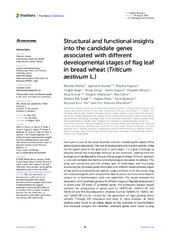Приказ основних података о документу
Structural and functional insights into the candidate genes associated with different developmental stages of flag leaf in bread wheat (Triticum aestivum L.)
| dc.creator | Mehla, Sheetal | |
| dc.creator | Kumar, Upendra | |
| dc.creator | Kapoor, Prexha | |
| dc.creator | Singh, Yogita | |
| dc.creator | Sihag, Pooja | |
| dc.creator | Sagwal, Vijeta | |
| dc.creator | Balyan, Priyanka | |
| dc.creator | Kumar, Anuj | |
| dc.creator | Ahalawat, Navjeet | |
| dc.creator | Lakra, Nita | |
| dc.creator | Pal Singh, Krishna | |
| dc.creator | Pešić, Vladan | |
| dc.creator | Đalović, Ivica | |
| dc.creator | Rouf Mir, Reyazul | |
| dc.creator | Parkash Dhankher, Om | |
| dc.date.accessioned | 2022-08-29T07:30:13Z | |
| dc.date.available | 2022-08-29T07:30:13Z | |
| dc.date.issued | 2022 | |
| dc.identifier.issn | 1664-8021 | |
| dc.identifier.uri | http://fiver.ifvcns.rs/handle/123456789/3078 | |
| dc.description.abstract | Grain yield is one of the most important aims for combating the needs of the growing world population. The role of development and nutrient transfer in flag leaf for higher yields at the grain level is well known. It is a great challenge to properly exploit this knowledge because all the processes, starting from the emergence of the flag leaf to the grain filling stages of wheat (Triticum aestivum L.), are very complex biochemical and physiological processes to address. This study was conducted with the primary goal of functionally and structurally annotating the candidate genes associated with different developmental stages of flag leaf in a comprehensive manner using a plethora of in silico tools. Flag leaf-associated genes were analyzed for their structural and functional impacts using a set of bioinformatics tools and algorithms. The results revealed the association of 17 candidate genes with different stages of flag leaf development in wheat crop. Of these 17 candidate genes, the expression analysis results revealed the upregulation of genes such as TaSRT1-5D, TaPNH1-7B, and TaNfl1-2B and the downregulation of genes such as TaNAP1-7B, TaNOL-4D, and TaOsl2-2B can be utilized for the generation of high-yielding wheat varieties. Through MD simulation and other in silico analyses, all these proteins were found to be stable. Based on the outcome of bioinformatics and molecular analysis, the identified candidate genes were found to play principal roles in the flag leaf development process and can be utilized for higher-yield wheat production. | sr |
| dc.language.iso | en | sr |
| dc.publisher | Frontiers Media S.A. | sr |
| dc.relation | SPARC/2018-2019/P854/SL by SPARC, the Ministry of Education, GOI, in collaboration with the University of Massachusetts, Amherst | sr |
| dc.rights | openAccess | sr |
| dc.rights.uri | https://creativecommons.org/licenses/by/4.0/ | |
| dc.source | Frontiers in Genetics | sr |
| dc.subject | flag leaf development | sr |
| dc.subject | homology modeling | sr |
| dc.subject | gene expression analysis | sr |
| dc.subject | qRT-PCR | sr |
| dc.subject | quantitative real-time polymerase chain reaction | sr |
| dc.subject | MD simulation | sr |
| dc.subject | wheat | sr |
| dc.subject | bread wheat | sr |
| dc.subject | Triticum aestivum | sr |
| dc.title | Structural and functional insights into the candidate genes associated with different developmental stages of flag leaf in bread wheat (Triticum aestivum L.) | sr |
| dc.type | article | sr |
| dc.rights.license | BY | sr |
| dc.citation.rank | M21 | |
| dc.citation.spage | 933560 | |
| dc.citation.volume | 13 | |
| dc.identifier.doi | 10.3389/fgene.2022.933560 | |
| dc.identifier.fulltext | http://fiver.ifvcns.rs/bitstream/id/8549/fgene-13-933560.pdf | |
| dc.identifier.scopus | 2-s2.0-85138028605 | |
| dc.type.version | publishedVersion | sr |


